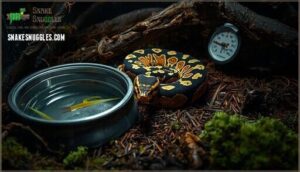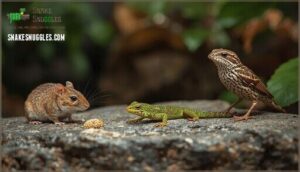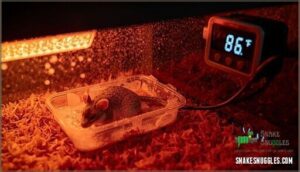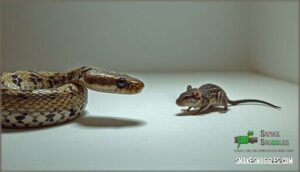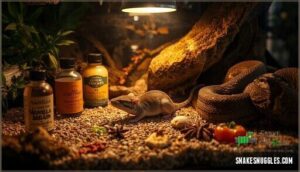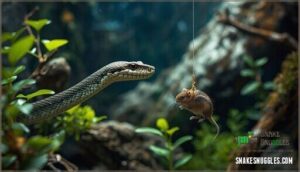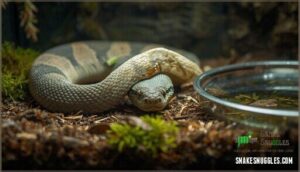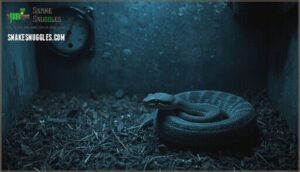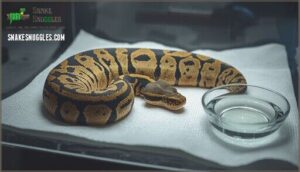This site is supported by our readers. We may earn a commission, at no cost to you, if you purchase through links.
 Your snake stares at a perfectly good mouse, flicks its tongue once, and turns away. You check the temperature gauge, the humidity levels, the hide box placement—everything seems right. But your snake hasn’t eaten in three weeks, and that initial curiosity is turning into worry. Appetite loss in snakes isn’t always a crisis, but it’s your snake’s way of telling you something is off.
Your snake stares at a perfectly good mouse, flicks its tongue once, and turns away. You check the temperature gauge, the humidity levels, the hide box placement—everything seems right. But your snake hasn’t eaten in three weeks, and that initial curiosity is turning into worry. Appetite loss in snakes isn’t always a crisis, but it’s your snake’s way of telling you something is off.
The cause could be as simple as an approaching shed or as complex as an internal infection you can’t see. Understanding the difference between normal fasting behavior and genuine health concerns requires working through environmental factors, natural cycles, and medical possibilities in a systematic way.
Here’s how to decode what your snake is trying to tell you and when it’s time to act.
Table Of Contents
- Key Takeaways
- Why is My Snake Not Eating?
- Reasons for Snake Refusal to Eat
- Changing Food Item or Presentation
- Trickery Methods
- Troubleshooting
- Natural Causes of Appetite Loss
- Environmental Causes of Appetite Loss
- Snake Diseases That Can Cause Appetite Loss
- Treatment and Prevention of Appetite Loss
- Frequently Asked Questions (FAQs)
- How long can a snake go without eating?
- How can I encourage my snake to eat?
- Is it normal for a snake to not eat for a month?
- Why isn’t my snake eating the mouse?
- How do I know if my snake is overweight?
- What are the signs of dehydration in snakes?
- How often should I handle my snake?
- Can I feed my snake live prey?
- What are the best substrate options for snakes?
- Can snakes stop eating during breeding season?
- Conclusion
Key Takeaways
- Appetite loss in snakes typically stems from environmental issues (temperature, humidity, lighting, stress), natural cycles (shedding, brumation, breeding season), or health problems (mouth rot, respiratory infections, parasites), with environmental factors accounting for roughly 90% of cases.
- Most feeding refusals resolve within days to weeks once you systematically address husbandry basics—maintaining proper temperature gradients (75-95°F with 90-92°F basking spots), humidity levels (60-80%), consistent 12-hour light cycles, and adequate hiding spots.
- Prey presentation matters significantly: warming frozen-thawed prey to 75-88°F, matching prey size to your snake’s body width, and using scenting techniques can trigger feeding responses in reluctant eaters without the injury risks that live prey poses.
- If your snake refuses food beyond four weeks despite correcting environmental conditions and trying different feeding methods, veterinary consultation becomes essential—early intervention within two weeks doubles recovery chances for underlying medical issues.
Why is My Snake Not Eating?
When your snake stops eating, several factors could be at play. Natural appetite cycles—like molting, seasonal changes, or growth spurts—are common and usually resolve within days to weeks. Environmental stressors matter too: improper temperatures, humidity levels, inadequate hiding spots, or stress from handling can suppress feeding.
Health issues ranging from mouth rot and respiratory infections to parasites also cause appetite loss. Internal issues like kidney or liver failure can also suppress appetite.
The key is systematically working through these possibilities. Start by checking your tank conditions, observing your snake’s behavior for signs of illness, and reviewing feeding practices. Most appetite loss responds well to addressing the underlying cause, whether that’s adjusting husbandry, changing food presentation, or seeking veterinary care when needed.
Reasons for Snake Refusal to Eat
A snake stops eating for many different reasons, and figuring out which one applies to your snake is the key to fixing the problem. Most of the time, the cause falls into one of four main categories: your snake mightn’t actually be hungry yet, it might’ve specific preferences about its food, something about its tank setup could be wrong, or it might’ve a health issue.
Let’s walk through each one so you can narrow down what’s going on with yours.
Assess Hunger Status
How can you tell if your snake is actually hungry? Start by watching for visual cues—increased tongue flicking, focused attention on movement, and active prowling indicate your snake’s appetite is kicking in. You’ll also notice behavioral indicators like head bobbing and restlessness as your snake searches its enclosure.
Consider these assessment methods:
- Observe hunger signals: Look for tongue flicking, glass surfing, and heightened activity levels that suggest metabolic readiness for food.
- Track body condition: Use visual and palpation checks to assess fat reserves and overall nutritional status, monitoring weight changes over time.
- Note timing factors: Account for shedding cycles, seasonal breeding periods, and your snake’s age—all physiological factors that naturally suppress appetite.
Remember, snakes have dramatically elevated metabolic rates during digestion, so hunger cues vary based on when your snake last ate. Observing a snake’s heightened activity levels near feeding times can also indicate hunger. If you’re unsure whether appetite loss signals a health concern, consult your veterinarian.
Determine Food Preferences
Every snake has food preferences shaped by species, prior experience, and individual personality. Ball pythons often prefer frozen-thawed mice or rats, while corn snakes may accept various prey types.
Watch your snake’s feeding response to different prey sizes and presentations—some prefer live prey that triggers hunting instincts, others accept frozen options readily. Scent preferences vary too; rubbing prey with a preferred scent can spark interest in reluctant feeders.
Experiment systematically with live versus frozen-thawed options and different prey types to identify what excites your snake’s appetite most.
Rule Out Husbandry Issues
Once you’ve identified your snake’s food preferences, shift focus to the environment itself—that’s where most feeding problems actually hide. Your enclosure’s temperature, humidity, lighting, and layout directly shape whether your snake wants to eat.
Start with the basics. Your snake needs a proper temperature gradient with a basking spot around 90–92°F; anything cooler suppresses appetite and digestion. Humidity matters too—most species do best at 60–80%, which keeps stress down and shedding smooth. A 12-hour light-dark cycle regulates feeding behavior and overall activity, so keep that consistent.
Then tackle the physical space. Inadequate hiding spots drive stress that kills appetite; snakes naturally spend about half their time concealed. Dirty substrate breeds infections like mouth rot and respiratory disease, so spot-clean weekly and fully disinfect every 90 days. Excessive handling and high-traffic areas also stress snakes into refusing food.
Check these five areas:
- Temperature gradients: Maintain 75–95°F with a 90–92°F basking zone
- Humidity levels: Keep 60–80% relative humidity appropriate to your species
- Lighting cycles: Provide 12 hours light, 12 hours darkness consistently
- Hiding places: Offer multiple secure hides to reduce stress-related refusal
- Substrate and tank conditions: Clean weekly, replace entirely every 90 days to prevent disease
Fix these husbandry basics first—they’re often the culprit.
Evaluate Health Concerns
What if your snake’s appetite problem isn’t behavioral or environmental, but medical? This is where careful evaluation becomes critical. Certain health conditions directly suppress feeding, so you’ll want to systematically check for them.
Start by examining your snake’s mouth for swelling, discharge, or discoloration—mouth rot affects nearly 30% of captive snakes and causes significant pain during eating. Listen for wheezing or labored breathing; respiratory infections reach infection rates up to 59% in some species and trigger immediate appetite loss. Watch for weight loss, lethargy, or abnormal droppings, which signal internal parasites, obstructions, or impactions.
Key health concerns to evaluate:
- Mouth Rot – Look for pus, swelling, or difficulty opening the mouth; bacterial infections make eating painful
- Respiratory Infections – Note nasal discharge, mucus, or open-mouth breathing that prevents normal feeding
- Internal Parasites – Check fecal samples; parasites cause gastrointestinal discomfort and nutrient loss
- Obstructions & Impactions – Observe for vomiting, abdominal distension, or absent bowel movements
If you spot any of these signs, contact a reptile veterinarian promptly. Early intervention dramatically improves outcomes and gets your snake eating again.
Changing Food Item or Presentation
Sometimes a snake refuses food simply because it doesn’t like what you’re offering or how you’re presenting it. Small adjustments to the prey type, temperature, or feeding method can often trigger a feeding response.
Here are some practical changes you can try to get your snake interested in eating again.
Adjust Prey Options
Different snakes have different prey preferences—what works for one mightn’t work for another. Start by offering varied prey types like rodents, birds, or lizards to match your snake’s natural diet. Prey size is very important; aim for items about 1 to 1.5 times your snake’s body width to promote safe swallowing.
Try presenting prey using tongs or different placements. You can also experiment with scenting options by rubbing chicken broth or tuna juice on frozen-thawed prey to trigger feeding responses. Variety in both prey item selection and presentation often reignites appetite in reluctant feeders.
Experiment With Heating Techniques
Temperature matters more than you’d think for feeding. Snakes rely on infrared detection to locate warm prey, so offering food at the right temperature dramatically improves feeding success. Aim for prey warmed to 75–88°F, depending on your species—ball pythons and corn snakes prefer the higher end.
Use safe heating methods: thaw frozen prey overnight in the refrigerator, then warm it in water around 95°F, or place it on a heat mat set to 85–90°F. Avoid overheating, which risks thermal burns and bacterial growth. Getting the temperature right often reignites appetite in reluctant feeders.
Consider Live Prey
When other methods haven’t worked, live prey can stimulate appetite through natural hunting triggers—but it’s genuinely a last resort. Live prey poses real risks: snakes can sustain bites, scratches, or internal injuries from prey fighting back, and injury rates from live feeding are documented in veterinary literature. There are also ethical concerns about prey suffering and disease transmission risks like parasites and Salmonella.
Before considering live prey, explore these safer alternatives:
- Scent frozen-thawed prey with preferred scents to mimic live prey’s appeal without injury risks
- Use euthanized prey to combine safety benefits with appetite-stimulating movement techniques
- Adjust prey temperature and presentation to trigger natural feeding responses
- Consult your veterinarian for species-specific methods adapted to your snake’s needs
Live feeding may work for reluctant feeders, but the risks—injury, disease, ethical concerns, and legal considerations in some regions—make it worth exhausting alternatives first. Your vet can guide you safely.
Scent Prey Items
Your snake’s sense of smell is remarkably powerful—it’s how they hunt in the wild. Scenting prey items leverages this natural instinct to overcome feeding reluctance. Research shows younger snakes respond particularly well to scent cues, making this technique especially effective for juveniles.
Apply these scenting techniques to stimulate appetite:
- Rub frozen-thawed prey with vanilla, cinnamon, or chicken broth
- Soak prey in scent solutions matching your snake’s natural diet
- Create scent trails leading to the food item
- Bruise prey to release natural attractant odors
- Experiment with multiple scents to find your snake’s preference
Start with familiar scents your snake encounters naturally. Younger snakes show stronger responses than adults, so age matters. This approach mimics natural prey cues without the risks live feeding carries.
Trickery Methods
Sometimes a snake won’t eat because it’s picky about what you’re offering or how you’re presenting it. If you’ve ruled out hunger, health issues, and environmental problems, it’s time to try some creative feeding strategies.
Here are some methods that can help trigger your snake’s natural hunting instincts and get it eating again.
Attach Desired Prey
When a picky eater refuses prey, combining attachment methods with strategic presentation can spark feeding interest. Connecting less desirable prey to your snake’s preferred option creates a bridge—the scent and movement of the desired item triggers the hunting response, while the alternative becomes an accessible backup. This works because prey selection hinges on size, scent imprinting, and nutritional content; your snake recognizes familiar cues and responds accordingly.
Key strategies for success:
- Attach complementary prey items using feeding tools like tweezers to position them together, allowing your snake to encounter preferred prey first
- Match prey size carefully—make sure neither item exceeds your snake’s gape size, as oversized prey causes refusal regardless of presentation
- Layer scent imprinting by rubbing preferred prey scent onto less desirable options, using olfactory cues that drive feeding behavior
- Alternate frozen-thawed and live prey presentations to determine which presentation method your snake reacts to most reliably
- Observe feeding tools and positioning—how you hold or move the prey matters; slight jerking movements mimic natural live prey behavior and activate predatory instincts
Train Feeding
Feeding training builds consistency and trust over time. Offer food at the same time daily to establish routine, then gradually present prey closer to your hand. Short 10–30 minute sessions work best—they minimize stress while letting your snake adjust to your presence.
Watch for behavioral cues like relaxed posture and increased activity, which signal readiness. Use feeding tools like tweezers or forceps to manipulate prey with gentle jerking movements that mimic live prey. Warmer prey (around 77–86°F) increases strike likelihood.
Patience matters; some snakes need weeks to respond reliably.
Scent Rodents
Building on consistent feeding routines, scenting techniques can stimulate your snake’s appetite when standard prey falls flat. Your snake relies heavily on smell to identify food, so enhancing prey with natural attractants or commercial scenting products mimics live prey more convincingly.
Here’s how to apply scenting methods effectively:
- Rub scent sources directly onto rodents — Fully thaw and warm the prey, then rub frog legs, quail, or lizard across the head and underside to transfer odor directly onto fur or skin.
- Create scented water or oil solutions — Soak prey items in water or oil for 30–60 minutes, then wipe or spray the solution onto your thawed rodent for even coverage.
- Use natural attractants — Apply peanut butter, fish oils (sardines, salmon, tuna), or specialized commercial scenting juices derived from prey sources directly to the rodent’s surface.
- Experiment with application methods — Try scent dispensers for consistent coverage, or insert scented items into small cuts on the prey for prolonged odor contact.
Start with one technique and observe your snake’s response before adjusting.
Use Euthanized Prey
Switching from scent additives, you might consider freshly euthanized prey as a feeding strategy. Safety benefits stand out—euthanized prey eliminates bite risks that live prey poses during feeding. Ethical considerations matter too, as humane euthanasia methods (CO2 inhalation, cervical dislocation) align with AVMA guidelines and reduce prey suffering. Acceptance rates for frozen-thawed prey exceed 80–90% in captive snakes, with younger animals adapting faster to prey preferences.
Here’s how to apply this method:
- Source humanely euthanized prey items from reputable suppliers following established euthanasia methods.
- Warm prey to body temperature (98–100°F) to activate scent receptors and mimic live prey selection.
- Observe your snake’s response to different prey preferences—some species show strong frozen-thawed prey acceptance while others need gradual introduction.
Troubleshooting
If your snake still won’t eat after trying different foods and methods, it’s time to step back and work through the problem systematically. Start by checking the basics, then move through each potential cause until you find what’s keeping your snake from feeding.
Here’s a practical troubleshooting checklist to help you identify and fix the issue.
Ensure Hunger Cues
Your snake won’t show hunger cues if its environment isn’t right. Check temperature gradients between 75-85°F for digestion, with basking spots at 90-92°F. Maintain lighting schedules of 12 hours light and dark to trigger natural feeding behavior. Guarantee proper humidity control around 50-60% and adequate enclosure size so your snake feels secure.
Watch for tongue flicking and active movement—these signal readiness to eat. Scent enrichment from prey can also stimulate snake appetite and improve prey presentation success.
Rule Out Logical Reasons
Before you panic, ask yourself: could something normal be causing the feeding refusal? Many snakes refuse food during predictable biological cycles, and understanding these patterns helps you separate normal behavior from genuine health concerns. Recent disruptions like moving enclosures or changes in routine can trigger hunger strikes lasting several weeks, with approximately 90% of feeding issues tied to environmental factors rather than illness.
- Shedding cycles: Snakes often stop eating days or weeks before molting and resume afterward
- Breeding season: Reproductive hormones suppress appetite temporarily in both males and females
- Brumation periods: Some species naturally reduce feeding during cooler months, even in captivity
- Recent habitat changes: New enclosures or temperature fluctuations cause stress-related refusal for weeks
Double-Check Husbandry
Once you’ve ruled out normal patterns, it’s time to scrutinize your enclosure setup. Environmental factors cause most feeding refusals, so verify that temperature gradients stay between 75-95°F with proper basking spots. Humidity levels should hover around 50-80% depending on species—ball pythons need 60-80%, while corn snakes tolerate slightly lower ranges.
Check that enclosure size allows full extension, hiding places provide adequate security, and the lighting cycle follows a consistent 12-hour pattern. Environmental conditions directly impact metabolism and appetite, so even slight deviations can trigger hunger strikes lasting weeks.
| Environmental Factor | What to Check |
|---|---|
| Temperature | Basking spot 90-95°F, ambient 75-85°F, nighttime above 65-75°F |
| Humidity | 50-80% depending on species; measure with reliable hygrometer |
| Enclosure Size | Allows full body extension; minimum 4x2x2 feet for larger species |
| Hiding Places | At least two hides (warm side and cool side) for security |
| Lighting Cycle | Consistent 12-hour day/night schedule without disruption |
Explore Food Options
If your snake refuses meals despite ideal conditions, diversifying the snake diet often resolves stubborn cases. Prey size matters most—offer items matching 10-15% of body weight, sized roughly equal to the snake’s thickest girth.
Experiment with prey preferences by alternating between frozen-thawed prey and live feeding options like mice, rats, or chicks. Try scenting techniques using frog or bird down to trigger instinctive responses.
Warm prey to body temperature and present various food types to maintain nutritional balance and stimulate appetite through food variety.
Consult a Veterinarian
If your snake refuses food for more than four to eight weeks despite fixing all environmental problems, a reptile veterinarian becomes essential. Professional intervention benefits include accurate diagnosis through diagnostic imaging needs like X-rays and blood work, which detect hidden issues in 35% of cases. Early intervention outcomes show that veterinarian visits within two weeks double recovery chances, while exotic vet costs commonly range from $65–$150 for consultation, with husbandry issue detection preventing recurrence in 80% of treated snakes.
- Vet’s Expertise in Reptile Health – Snake veterinary care specialists identify systemic illness, infections, and parasites missed by owners.
- Medication Options and Dosages – Veterinarians prescribe antibiotics or antiparasitic drugs following lab confirmation in over half of cases.
- Long-Term Monitoring for Recovery – Follow-up appointments make certain environmental corrections stick, maintaining recovery in 85% of treated snakes.
Natural Causes of Appetite Loss
Not every feeding refusal means something’s wrong with your snake. Sometimes, appetite loss is just part of being a snake.
Let’s look at the natural reasons your snake might skip a meal or two.
Molting
Your snake stops eating during molting because its body prioritizes skin renewal over digestion. This natural process, called ecdysis, happens every 30 days under normal conditions and involves significant hormonal shifts controlled by thyroid activity.
During the pre-shedding phase, your snake’s eyes turn blue or opaque as fluid separates old and new skin layers. This visual impairment triggers behavioral changes that reduce feeding interest by up to 6% per cycle. Here’s what happens:
- Sensory disruption: Clouded vision and reduced strike frequency make hunting feel risky during vulnerability.
- Metabolic shift: Energy redirects toward epidermal regeneration rather than digestion and foraging.
- Appetite suppression: Feeding refusal generally lasts 5–10 days before and after shedding completes.
Your juvenile snake may fast for shorter periods due to faster metabolic cycling. Once the shed finishes, appetite returns to normal.
Maintain 50–70% humidity and proper temperature gradients to support smooth ecdysis and minimize feeding disruption.
Seasonal Changes
Ever wonder why your snake skips meals as the seasons shift? Seasonal changes trigger appetite loss through temperature fluctuations, photoperiod impact, and reproductive cycles.
Cooler days slow metabolism, while winter inactivity and snake brumation spark brumation anorexia. Lower prey availability means longer fasting.
These shifts reflect natural seasonal behavior in snakes, not a sign of illness.
Hibernation Attempts
During brumation, your snake enters a winter dormancy state where its metabolic slowdown triggers complete fasting. As temperatures drop, your snake’s body conserves energy and water, ceasing all feeding until spring arrives. Cold stress suppresses appetite during this hibernation behavior, even if food is offered.
Here’s what to expect during brumation cycles:
- Your snake won’t eat as metabolism slows with falling temperatures
- Hibernation behavior is triggered by environmental cues, not food availability
- Your snake may emerge briefly on warmer winter days to drink but won’t feed
- Winter inactivity can last weeks or months depending on your climate and species
This seasonal change is completely normal. Don’t worry if your snake refuses meals during this period—it’s a natural survival mechanism, not illness.
Age Factors
As your snake matures, its metabolic rate naturally declines. Older snakes require fewer meals than juveniles—what once demanded feeding every five to seven days may now stretch to two to four weeks, depending on species and size. This shift reflects their slowed metabolism and stabilized body weight. You’ll notice senior snakes eat less frequently and sometimes smaller portions. Rather than interpreting this as illness, recognize it as normal aging. Adjust your feeding schedule accordingly, offering appropriately sized prey at longer intervals while monitoring body condition to verify your aging snake maintains healthy weight.
| Age Stage | Typical Feeding Interval | Metabolic Rate | Nutritional Focus |
|---|---|---|---|
| Juvenile | Every 5–7 days | High | Growth support |
| Young Adult | Every 7–14 days | Moderate | Maintenance |
| Mature Adult | Every 1–4 weeks | Lower | Stability |
| Senior Snake | Every 2–4 weeks | Declining | Weight maintenance |
Growth Spurts
During growth phases, your young snake’s body undergoes intense metabolic demands. Juvenile ball pythons, for instance, activate 2,000 to 3,000 genes within 12 hours of feeding—orchestrating rapid organ enlargement and tissue remodeling. This physiological intensity sometimes triggers temporary fasting periods as your snake’s body prioritizes growth over feeding. Rather than signal illness, this represents normal growth cycling.
- Growth spurts require doubled metabolic rates and frequent feeding every 1–2 weeks for juveniles
- Young snakes may refuse food while organs rapidly enlarge and cellular reorganization occurs
- Maintain ideal temperatures (85–90°F) to support metabolism and appetite during development phases
Environmental Causes of Appetite Loss
Your snake’s environment plays a major role in whether it’ll eat or refuse food. Even small problems with temperature, lighting, or tank setup can trigger appetite loss.
Let’s look at the specific environmental factors that might be affecting your snake’s feeding behavior.
Inappropriate Substrate
Your substrate choice directly shapes your snake’s stress levels and feeding response. Snakes housed in shallow or bare enclosures struggle to burrow or thermoregulate effectively, leading to anxiety that can suppress their appetite. Conversely, deep, naturalistic substrates allow your snake to engage in species-specific behaviors, such as burrowing to cooler zones for digestion or basking where needed. These behaviors are strongly linked to improved feeding success.
Substrate maintenance is equally crucial. Dirty bedding can harbor bacteria that compromise gut health, while inadequate moisture disrupts the humidity levels essential for your snake’s well-being. To mitigate these risks, replace the substrate every one to two weeks and select a type that supports your species’ thermal gradients without posing an impaction risk during feeding.
Key considerations:
- Substrate depth and composition facilitate burrowing and thermoregulation, reducing stress-related appetite loss
- Regular replacement prevents bacterial buildup that causes infection and feeding refusal
- Proper moisture balance maintains humidity levels essential for your snake’s digestion and shedding
Incorrect Daylight-Darkness Cycle
Your snake’s circadian rhythm directly controls feeding drive, making the light cycle one of the most overlooked appetite factors. Snakes kept under constant artificial lighting or irregular photoperiods experience disrupted circadian entrainment, which suppresses hunger signals and delays digestion. Research shows snakes exposed to inconsistent lighting schedules exhibit up to 60% reduced feeding rates compared to properly controlled environments.
To restore normal feeding behavior:
- Maintain a strict 12-hour light and 12-hour dark cycle using automatic timers to prevent fluctuations that confuse your snake’s internal clock
- Verify your basking area reaches 90–92°F during the light phase, allowing proper thermoregulation needed for digestion after feeding
- Provide uninterrupted darkness at night, as even low artificial light elevates stress hormones that suppress appetite and feeding motivation
Seasonal photoperiod variations also matter. Gradually adjusting lighting by 10–15 minutes weekly can mimic natural seasonal changes, stabilizing appetite and reducing fasting-related stress throughout the year.
Unsuitable Food
Prey type mismatch is a leading cause of feeding refusal. Your snake’s natural diet shapes what it’ll accept—ball pythons refusing mice for rats, or boas rejecting unfamiliar prey species. Inappropriate prey substitution accounts for 25–37% of chronic fasting episodes.
Temperature matters too. Warm prey (around 35°C) triggers 60% stronger feeding responses than cold items. Unheated frozen-thawed prey elicits only one-third of predatory strikes, so defrost thoroughly using warm water or a hairdryer.
Scent recognition drives acceptance. When prey odor matches your snake’s natural food source, feeding acceptance jumps up to 68%. Offering variety—rotating between different rodent sizes and occasionally trying live prey—keeps feeding instincts sharp.
| Factor | Impact on Feeding |
|---|---|
| Prey type mismatch | 25–37% of chronic fasting cases |
| Cold prey temperature | 67% reduction in strike success |
| Unfamiliar scent profile | 32% of refusal cases |
| Proper scent matching | Up to 68% acceptance increase |
| Live vs. pre-killed | 2× higher strike engagement with live |
Feeding frequency also influences appetite. Overfeeding suppresses hunger signals, while spacing meals 1–2 weeks apart for ball pythons maintains natural feeding drive. If your snake refuses food, check prey size first—it shouldn’t exceed the widest part of your snake’s body.
Lack of Privacy
Your snake may refuse food when it feels too exposed. Snakes without adequate hiding opportunities exhibit up to 60% longer delays before feeding, and enclosure design directly impacts behavioral indicators of stress. Privacy concerns affect feeding consistency across all captive species.
Here’s how to improve your snake’s feeding environment:
- Install dual hides—place one on the warm side and one on the cool side to reduce refusal rates by 37% while promoting stress reduction.
- Add visual barriers—use cork bark, plants, or opaque backgrounds to minimize human visibility and decrease defensive strikes by 48%.
- Adjust lighting—dim lights during feeding times encourage natural ambush behavior and improve acceptance rates by 33% in shy species.
Snakes in cluttered, naturalistic enclosures with multiple hiding spots feed 20% more consistently than those in bare tanks. If your snake constantly hides or won’t explore, it’s signaling insufficient privacy. Excessive handling above 30 minutes daily compounds the problem, suppressing appetite further. Provide cover materials and limit disturbances—most snakes resume normal feeding within 5–7 days once privacy improves.
Stress
When handling stress in snakes pushes past their comfort zone, you’re looking at a recipe for refusing food—over 60% of chronically stressed captive snakes stop eating regularly. Stress factors like excessive handling, enclosure stressors (overcrowding, temperature swings, loud noises), shedding stress, and reproductive stress all increase corticosterone levels, triggering appetite suppression that can last weeks. Managing stress in snakes requires recognizing signs of snake stress early and implementing stress mitigation strategies immediately.
- Limit handling to once weekly during acclimation periods
- Maintain stable temperature and humidity without fluctuations exceeding 5°C
- Provide multiple hides and environmental enrichment like climbing structures
- Minimize vibrations, loud sounds, and high-traffic disturbances near the enclosure
- Allow privacy during shedding cycles when behavioral factors, stress, and anxiety peak naturally
Snake Diseases That Can Cause Appetite Loss
Sometimes illness is the culprit behind your snake’s refusal to eat. Health problems can make eating difficult, painful, or simply unappealing to your pet.
Let’s look at the most common diseases that affect a snake’s appetite.
Mouth Rot
Mouth rot, or infectious stomatitis, hits hard when husbandry conditions fall short—over one-third of captive snakes can develop this painful infection. Bacteria like Aeromonas cause most cases, and without antibiotic treatment, the mortality rate climbs to 25% in severe infections.
You’ll notice inflamed gums, yellow oral pus, and your snake refusing meals because eating hurts. Catch it early, fix the environment, and your vet can turn things around with a 90% recovery rate.
Respiratory Disease
Respiratory infections bring snakes to the vet more than almost any other issue—about 20% of all exotic pet visits. You’ll spot wheezing, nasal discharge, and your snake refusing food for weeks because breathing takes priority over eating.
Bacterial infections from Mycoplasma or Pseudomonas thrive when temperatures drop below 75°F.
Your vet can prescribe antibiotics and nebulization therapy, which cuts appetite suppression by 30–40% and gets your snake eating again within two weeks if you correct the temperature and humidity fast.
Intestinal Parasites
Internal parasites show up in over one-third of captive snakes and turn healthy appetites upside down. You’ll notice weight loss, diarrhea, or regurgitation in 70% of cases, especially if your snake came from the wild.
Here’s what you need to know about parasite identification and treatment:
- Fecal exams catch nematodes and protozoans before they steal too many nutrients
- Deworming protocols using fenbendazole work in 92% of cases when your veterinarian prescribes the right dose
- Preventative measures include biannual fecal screening to cut re-infection rates by 60%
- Zoonotic potential means some parasites can spread to humans, so wash your hands thoroughly
- Species differences matter—hognose snakes carry parasites nearly twice as often as corn snakes due to their amphibian diet
Your vet can run a quick fecal exam and start treatment that restores your snake’s appetite within weeks.
Obstructions
Swallowed substrate or prey that’s too big accounts for roughly 10% of appetite loss cases—and it’s not something your snake can work out on its own. Foreign objects like wood chips create gastro obstruction in the intestine, while oversized meals cause intestinal blockage that halts digestion completely. Radiographs reveal that 40-50% of obstructions involve prey items your snake couldn’t handle.
You’ll notice abdominal swelling, lethargy, and refusal to eat beyond normal fasting periods. Surgical removal works in 75% of cases when caught early, before infection spreads.
Prevent bowel impaction by choosing appropriate substrate and matching prey size to your snake’s girth—digestive issues don’t fix themselves.
Impactions
While obstructions come from swallowed objects, impaction stems from dehydration and low humidity—and it’s diagnosed in about 12% of appetite loss cases. Snake constipation happens twice as often when humidity drops below 40%. You’ll see abdominal bloating, lethargy, and refusal to eat for weeks.
Warm baths resolve 55% of cases, but impaction treatment may require surgery, which succeeds 85% of the time.
Keep humidity at 60-70% to prevent gut obstruction and digestive issues that trigger infections or worsen existing intestinal parasites.
Treatment and Prevention of Appetite Loss
Once you’ve ruled out natural causes like shedding or seasonal changes, it’s time to look at what you can actually fix.
Addressing appetite loss means checking your husbandry, adjusting feeding practices, and watching for signs of illness.
Let’s walk through the key steps that can get your snake eating again.
Ensure Proper Environment
Think of your snake’s enclosure as its personal comfort zone—get it wrong, and appetite vanishes. You need to maintain temperature gradients of 80–90°F with a basking spot, humidity levels between 60–80%, and a 12-hour lighting cycle.
Enclosure size matters too—cramped quarters stress snakes out. Choose quality substrate like coconut fiber to support these environmental factors, and always include hiding spots to reduce anxiety-driven fasting.
Offer Appropriate Food
Getting your snake’s diet right involves choosing prey that matches your snake’s feeding guide. Prey size should equal the widest part of your snake’s body—about 10-15% of body weight—to prevent regurgitation or digestive stress. Food variety and nutrient balance matter, so offer whole rodents (mice for juveniles, rats for adults) that provide complete nutrition.
Follow a feeding schedule: juveniles eat every 5-7 days, while adults need meals every 1-2 weeks. Meal presentation counts too—thaw frozen prey to 37°C and use feeding tongs to mimic natural movement, triggering your snake’s strike response.
- Match prey preference to your snake’s natural diet (rodents for most species)
- Warm thawed prey properly and experiment with scenting techniques if refusals occur
- Stick to species-appropriate feeding schedules to avoid overfeeding or nutritional gaps
Monitor Enclosure Temperature
Temperature regulation is critical for your snake’s appetite and survival. A thermal gradient with a warm zone of 80-85°F and a cool zone of 75-80°F is essential, as temperatures below 78°F for more than 48 hours often lead to food refusal. Basking spots should not exceed 85°F to prevent stress, and nighttime temperatures can safely drop into the low 70s.
Use digital thermometers with dual probes for accuracy—they are 95% more reliable than analog gauges. Monitor both ground-level heat sources and air temperature to ensure optimal conditions. Humidity levels between 60-80% work in tandem with temperature to support digestion and prevent respiratory issues that can diminish appetite.
Environmental factors like these directly influence brumation triggers and metabolic function. Maintaining stable conditions within the recommended ranges can often restore feeding within 72 hours.
| Temperature Zone | Target Range |
|---|---|
| Warm Zone | 80-85°F |
| Cool Zone | 75-80°F |
| Basking Area | 85°F maximum |
| Nighttime | Low 70s°F |
| Humidity | 60-80% |
Check for Health Issues
Vigilance is your best defense against health conditions that cause appetite loss. Watch for mouth rot—swollen gums, thick discharge, or open-mouth breathing—which affects up to 77% of captive pythons.
Respiratory issues like wheezing or nasal discharge signal infections requiring immediate veterinary care. Intestinal parasites cause weight loss and regurgitation, detected through fecal analysis.
Obstructions from substrate ingestion or organ failure also trigger anorexia. If your snake refuses food beyond natural causes like shedding, consult a reptile veterinarian promptly for diagnosis and treatment of snake diseases or parasite infection.
Frequently Asked Questions (FAQs)
How long can a snake go without eating?
Healthy snakes can fast for surprisingly long periods—ball pythons for up to 6 months, sometimes longer. However, regular feeding every 1-3 weeks promotes peak health.
Extended fasting happens naturally during shedding, brumation, or breeding seasons, but prolonged inappetence warrants investigation.
How can I encourage my snake to eat?
Try varying prey types or scenting with chicken broth to trigger feeding responses. Wiggling thawed prey mimics live movement and often stimulates appetite. Offer prey in a dark, quiet space to reduce stress.
Make certain your enclosure has proper temperatures—a 90-92°F basking spot is vital for digestion.
If your snake still won’t eat after environmental adjustments, consult a reptile veterinarian to rule out health issues.
Is it normal for a snake to not eat for a month?
Yes, it’s normal for your snake to fast for a month. Species like boas and pythons often go 1-3 months without food, especially during shedding, brumation, or seasonal changes.
This adaptive behavior reflects their slow metabolism and natural fasting duration, which varies by species.
Why isn’t my snake eating the mouse?
When your snake turns up its nose at a mouse, think of it like pushing away a meal that just doesn’t hit the spot. Your snake might refuse food due to incorrect prey size, prey temperature that’s too cold, an inconsistent feeding schedule, or the presentation method.
Try adjusting prey preferences by offering food variety, experimenting with live vs frozen thawed options, using scenting techniques, or improving prey presentation with different feeding techniques to trigger your snake’s natural hunting response.
How do I know if my snake is overweight?
You can tell if your snake’s overweight by checking its body condition score and dorsal profile. Look for palpable fat deposits along the sides, scale separation, and a rounded shape instead of a visible spine. Overweight snakes face serious health risk factors, while underfeeding causes malnutrition.
Regular weight monitoring helps prevent both extremes—a healthy snake should have defined muscle tone without excess fat or visible ribs. If you’re unsure, consult a vet to assess your snake’s condition and adjust feeding for proper weight loss if needed.
What are the signs of dehydration in snakes?
Dehydration shows up in several key ways you can spot during routine checks. Look for sunken eyes, wrinkled or loose skin that lacks elasticity, and dry or crumbly waste products.
Behavioral changes like lethargy or increased soaking also signal your snake needs more hydration.
How often should I handle my snake?
Most snakes do well with handling 2 to 3 times weekly for 10 to 20 minutes. Overhandling increases stress indicators and can trigger defensive behavior or appetite loss.
Give your snake 48 hours after feeding before any handling to prevent regurgitation.
Can I feed my snake live prey?
Honestly? You can, but it’s like bringing a loaded weapon to dinner—unnecessary and dangerous. Most experts strongly discourage live prey feeding because rodents bite back, causing severe injuries or even death to your snake.
Live prey feeding is unnecessary and dangerous—rodents fight back, causing severe or fatal injuries to your snake
Frozen-thawed prey is nutritionally identical, safer, and spares both animals unnecessary stress and suffering.
What are the best substrate options for snakes?
Choosing the right substrate type matters for your snake’s health and comfort. Cypress mulch holds moisture well, supporting humidity maintenance for tropical species while allowing natural burrowing behaviors. Coconut fiber offers excellent thermal conductivity and moisture retention.
Reptile carpet simplifies hygiene practices and eliminates substrate impaction risk. Paper towels work for quarantine or medical monitoring.
Your snake enclosure environment should match your species’ needs—consider how substrate affects temperature gradients and cleaning frequency when selecting materials for your enclosure.
Can snakes stop eating during breeding season?
Yes, snakes can stop eating during breeding season. Hormonal influence drives this behavioral adaptation, particularly in females. Elevated progesterone and estradiol suppress appetite, redirecting energy allocation toward reproduction. Males may also refuse food when focused on mating activities.
Conclusion
Here’s the irony: you’ve probably spent more time Googling "why is my snake not eating" than your snake has spent actually thinking about food. Snakes aren’t dramatic—they’re precise. When they refuse a meal, they’re responding to something specific: wrong temperature, wrong timing, wrong health status.
You’ve now worked through environmental checks, natural cycles, and medical red flags. Most feeding strikes resolve with minor adjustments to husbandry or patience through a shed cycle. But if your snake continues refusing food beyond four weeks despite correcting all variables, a veterinary exam isn’t optional—it’s overdue.
- https://amccorona.com/wp-content/uploads/2020/05/ARAV_trifold_ball_pythonv2_2.pdf
- https://www.wilbanksreptiles.com/blogs/ball-python/ball-python-enclosure-health-guide
- https://www.napoleonvet.com/pet-health/snake-reptile-health
- https://www.silverappleexotics.com/feeding-issues-in-hognose-snakes.html
- https://www.petplace.com/article/reptiles/general/anorexia-in-snakes

